Managing Aging Population: A System Approach in the Australian Context
VerifiedAdded on 2023/06/07
|8
|2547
|111
Essay
AI Summary
This essay delves into the challenges and opportunities presented by an aging population, particularly within the Australian context. It advocates for a system thinking approach to address issues such as workforce participation, retirement, and age discrimination. The paper highlights the need for organizations to adapt strategies, including age audits, training programs, and flexible work arrangements, to retain and support older workers. It emphasizes the importance of understanding stereotypes, promoting intergenerational collaboration, and considering the financial and health implications of retirement. The essay also explores the role of policy makers in providing variable age pension alternatives and the need for families to adapt to changing workforce dynamics. Ultimately, the paper proposes that by embracing a system thinking approach, Australia can effectively manage its aging population, ensuring economic sustainability and the well-being of its older citizens. This assignment is available on Desklib, a platform offering AI-powered study tools and resources.
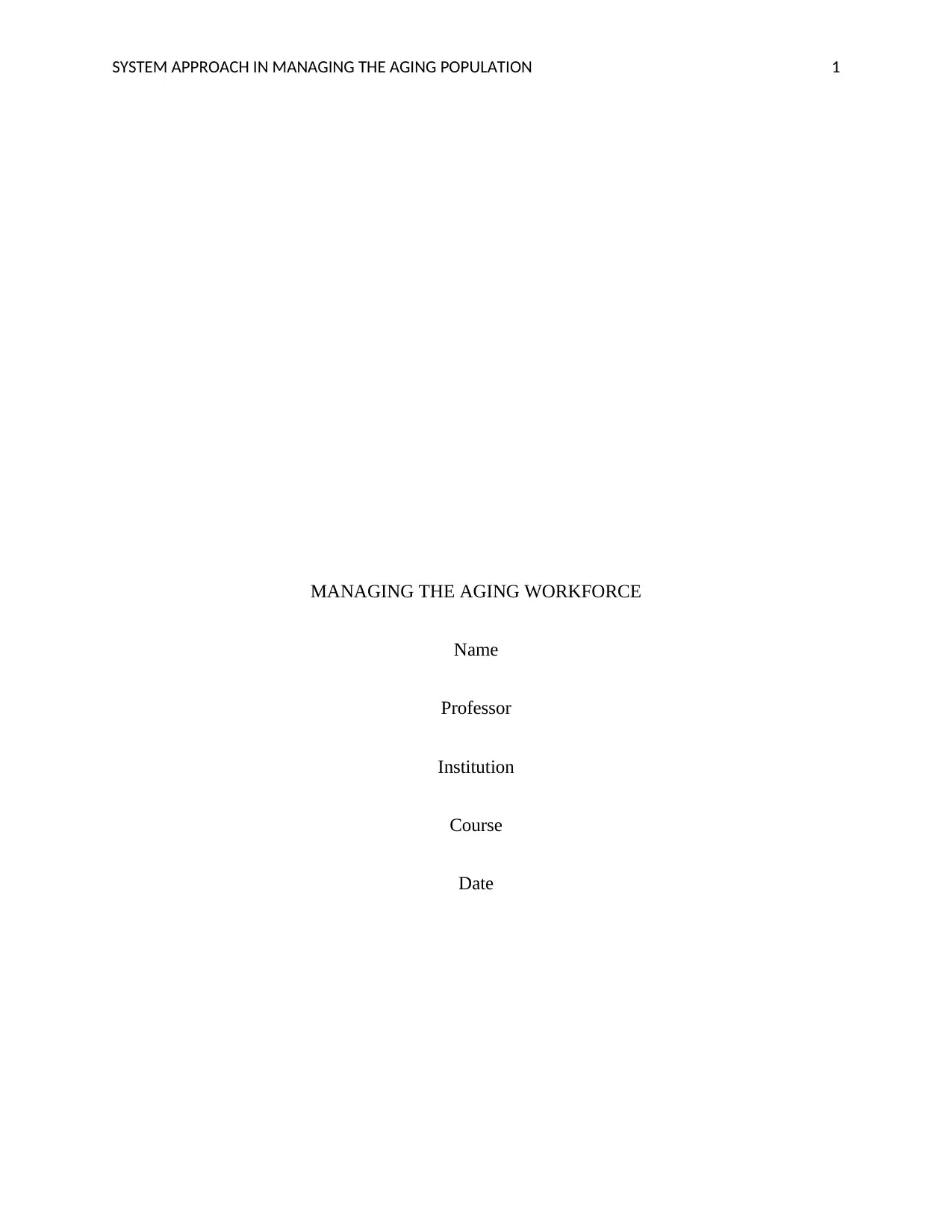
SYSTEM APPROACH IN MANAGING THE AGING POPULATION 1
MANAGING THE AGING WORKFORCE
Name
Professor
Institution
Course
Date
MANAGING THE AGING WORKFORCE
Name
Professor
Institution
Course
Date
Paraphrase This Document
Need a fresh take? Get an instant paraphrase of this document with our AI Paraphraser
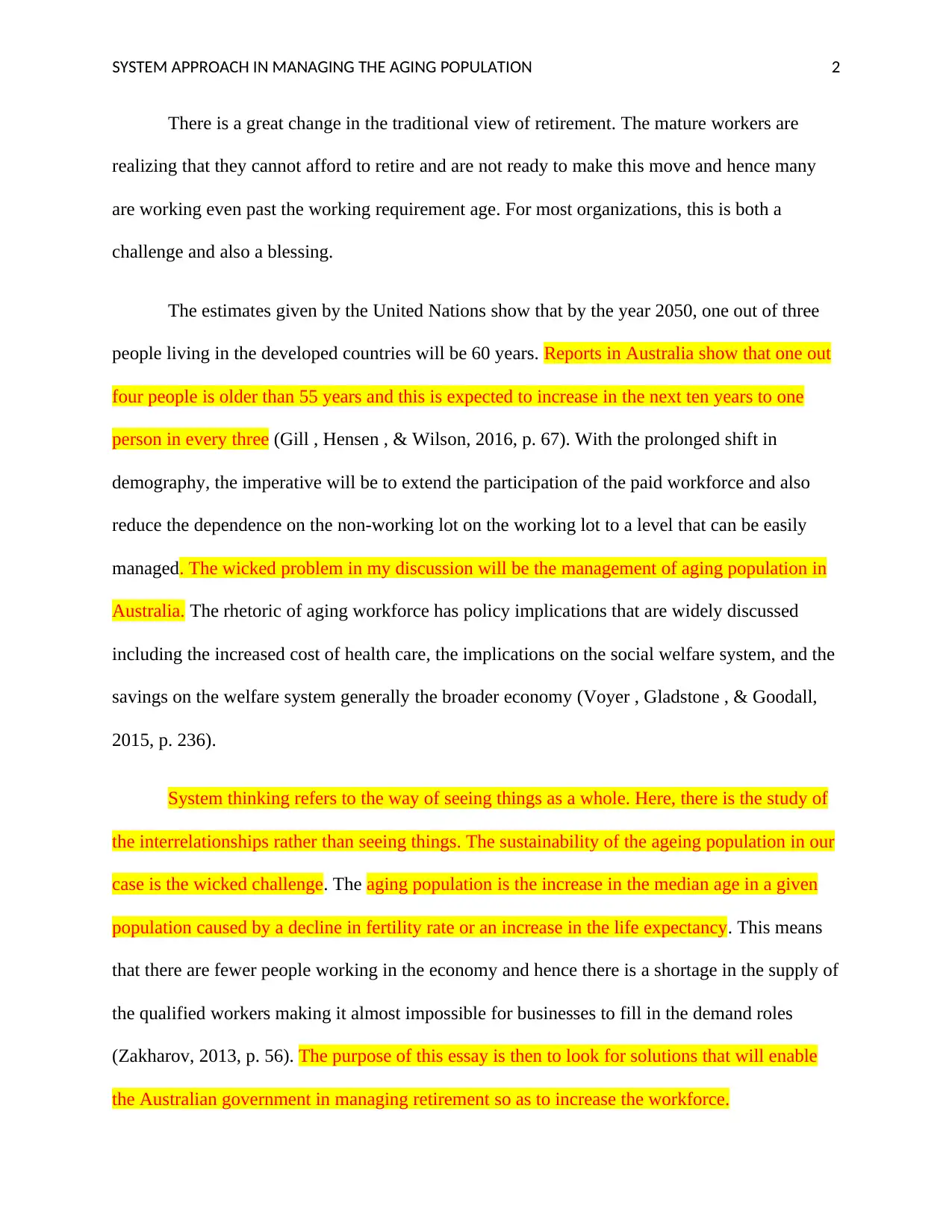
SYSTEM APPROACH IN MANAGING THE AGING POPULATION 2
There is a great change in the traditional view of retirement. The mature workers are
realizing that they cannot afford to retire and are not ready to make this move and hence many
are working even past the working requirement age. For most organizations, this is both a
challenge and also a blessing.
The estimates given by the United Nations show that by the year 2050, one out of three
people living in the developed countries will be 60 years. Reports in Australia show that one out
four people is older than 55 years and this is expected to increase in the next ten years to one
person in every three (Gill , Hensen , & Wilson, 2016, p. 67). With the prolonged shift in
demography, the imperative will be to extend the participation of the paid workforce and also
reduce the dependence on the non-working lot on the working lot to a level that can be easily
managed. The wicked problem in my discussion will be the management of aging population in
Australia. The rhetoric of aging workforce has policy implications that are widely discussed
including the increased cost of health care, the implications on the social welfare system, and the
savings on the welfare system generally the broader economy (Voyer , Gladstone , & Goodall,
2015, p. 236).
System thinking refers to the way of seeing things as a whole. Here, there is the study of
the interrelationships rather than seeing things. The sustainability of the ageing population in our
case is the wicked challenge. The aging population is the increase in the median age in a given
population caused by a decline in fertility rate or an increase in the life expectancy. This means
that there are fewer people working in the economy and hence there is a shortage in the supply of
the qualified workers making it almost impossible for businesses to fill in the demand roles
(Zakharov, 2013, p. 56). The purpose of this essay is then to look for solutions that will enable
the Australian government in managing retirement so as to increase the workforce.
There is a great change in the traditional view of retirement. The mature workers are
realizing that they cannot afford to retire and are not ready to make this move and hence many
are working even past the working requirement age. For most organizations, this is both a
challenge and also a blessing.
The estimates given by the United Nations show that by the year 2050, one out of three
people living in the developed countries will be 60 years. Reports in Australia show that one out
four people is older than 55 years and this is expected to increase in the next ten years to one
person in every three (Gill , Hensen , & Wilson, 2016, p. 67). With the prolonged shift in
demography, the imperative will be to extend the participation of the paid workforce and also
reduce the dependence on the non-working lot on the working lot to a level that can be easily
managed. The wicked problem in my discussion will be the management of aging population in
Australia. The rhetoric of aging workforce has policy implications that are widely discussed
including the increased cost of health care, the implications on the social welfare system, and the
savings on the welfare system generally the broader economy (Voyer , Gladstone , & Goodall,
2015, p. 236).
System thinking refers to the way of seeing things as a whole. Here, there is the study of
the interrelationships rather than seeing things. The sustainability of the ageing population in our
case is the wicked challenge. The aging population is the increase in the median age in a given
population caused by a decline in fertility rate or an increase in the life expectancy. This means
that there are fewer people working in the economy and hence there is a shortage in the supply of
the qualified workers making it almost impossible for businesses to fill in the demand roles
(Zakharov, 2013, p. 56). The purpose of this essay is then to look for solutions that will enable
the Australian government in managing retirement so as to increase the workforce.
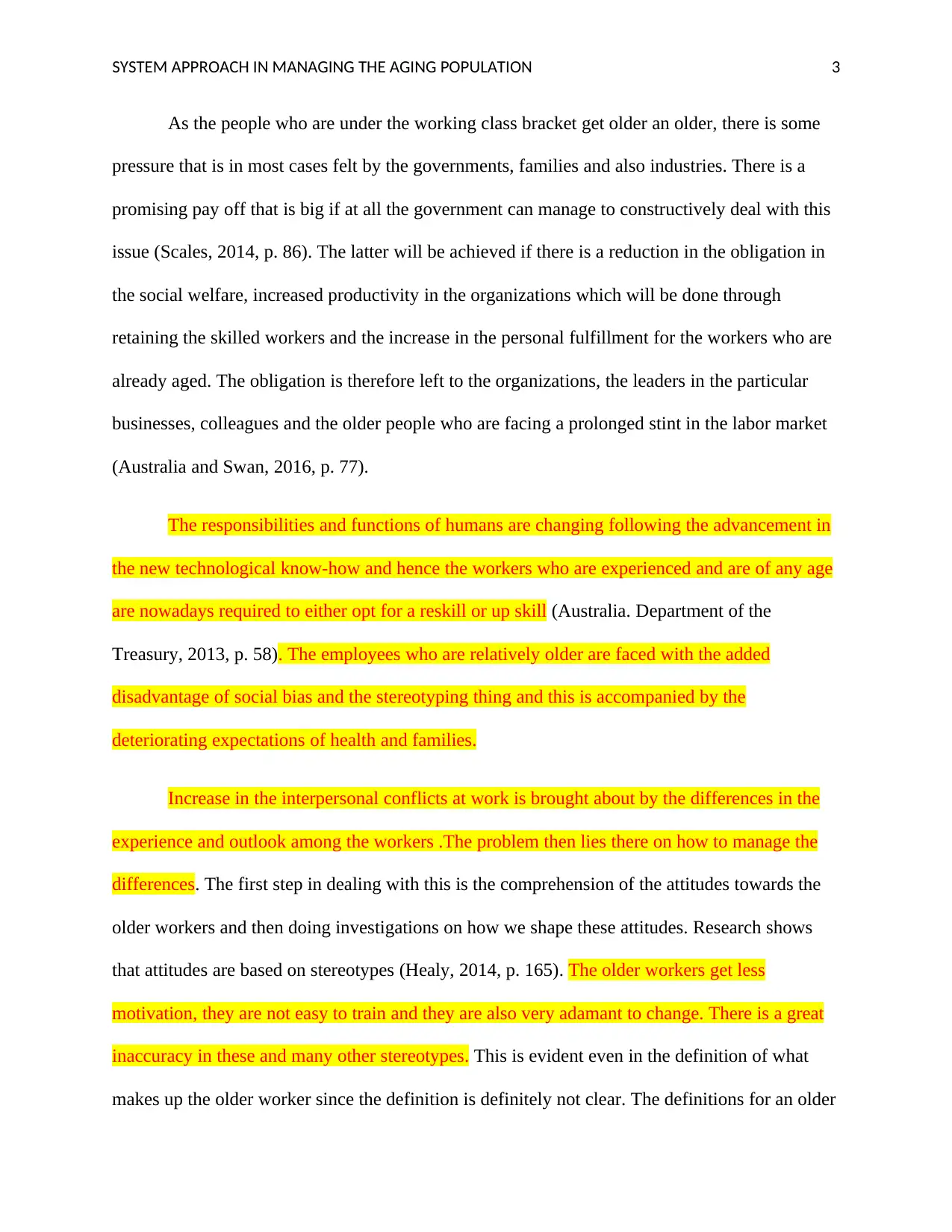
SYSTEM APPROACH IN MANAGING THE AGING POPULATION 3
As the people who are under the working class bracket get older an older, there is some
pressure that is in most cases felt by the governments, families and also industries. There is a
promising pay off that is big if at all the government can manage to constructively deal with this
issue (Scales, 2014, p. 86). The latter will be achieved if there is a reduction in the obligation in
the social welfare, increased productivity in the organizations which will be done through
retaining the skilled workers and the increase in the personal fulfillment for the workers who are
already aged. The obligation is therefore left to the organizations, the leaders in the particular
businesses, colleagues and the older people who are facing a prolonged stint in the labor market
(Australia and Swan, 2016, p. 77).
The responsibilities and functions of humans are changing following the advancement in
the new technological know-how and hence the workers who are experienced and are of any age
are nowadays required to either opt for a reskill or up skill (Australia. Department of the
Treasury, 2013, p. 58). The employees who are relatively older are faced with the added
disadvantage of social bias and the stereotyping thing and this is accompanied by the
deteriorating expectations of health and families.
Increase in the interpersonal conflicts at work is brought about by the differences in the
experience and outlook among the workers .The problem then lies there on how to manage the
differences. The first step in dealing with this is the comprehension of the attitudes towards the
older workers and then doing investigations on how we shape these attitudes. Research shows
that attitudes are based on stereotypes (Healy, 2014, p. 165). The older workers get less
motivation, they are not easy to train and they are also very adamant to change. There is a great
inaccuracy in these and many other stereotypes. This is evident even in the definition of what
makes up the older worker since the definition is definitely not clear. The definitions for an older
As the people who are under the working class bracket get older an older, there is some
pressure that is in most cases felt by the governments, families and also industries. There is a
promising pay off that is big if at all the government can manage to constructively deal with this
issue (Scales, 2014, p. 86). The latter will be achieved if there is a reduction in the obligation in
the social welfare, increased productivity in the organizations which will be done through
retaining the skilled workers and the increase in the personal fulfillment for the workers who are
already aged. The obligation is therefore left to the organizations, the leaders in the particular
businesses, colleagues and the older people who are facing a prolonged stint in the labor market
(Australia and Swan, 2016, p. 77).
The responsibilities and functions of humans are changing following the advancement in
the new technological know-how and hence the workers who are experienced and are of any age
are nowadays required to either opt for a reskill or up skill (Australia. Department of the
Treasury, 2013, p. 58). The employees who are relatively older are faced with the added
disadvantage of social bias and the stereotyping thing and this is accompanied by the
deteriorating expectations of health and families.
Increase in the interpersonal conflicts at work is brought about by the differences in the
experience and outlook among the workers .The problem then lies there on how to manage the
differences. The first step in dealing with this is the comprehension of the attitudes towards the
older workers and then doing investigations on how we shape these attitudes. Research shows
that attitudes are based on stereotypes (Healy, 2014, p. 165). The older workers get less
motivation, they are not easy to train and they are also very adamant to change. There is a great
inaccuracy in these and many other stereotypes. This is evident even in the definition of what
makes up the older worker since the definition is definitely not clear. The definitions for an older
⊘ This is a preview!⊘
Do you want full access?
Subscribe today to unlock all pages.

Trusted by 1+ million students worldwide
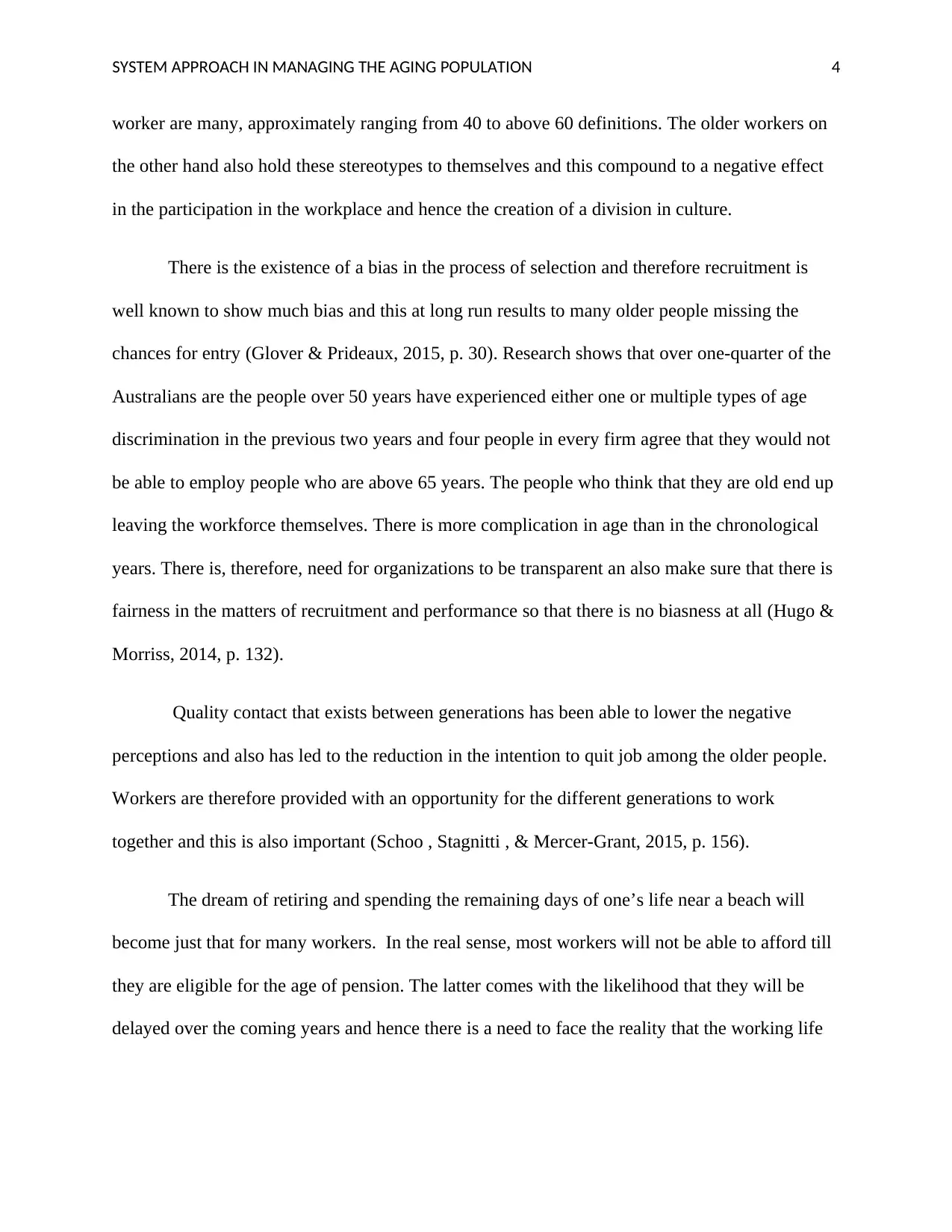
SYSTEM APPROACH IN MANAGING THE AGING POPULATION 4
worker are many, approximately ranging from 40 to above 60 definitions. The older workers on
the other hand also hold these stereotypes to themselves and this compound to a negative effect
in the participation in the workplace and hence the creation of a division in culture.
There is the existence of a bias in the process of selection and therefore recruitment is
well known to show much bias and this at long run results to many older people missing the
chances for entry (Glover & Prideaux, 2015, p. 30). Research shows that over one-quarter of the
Australians are the people over 50 years have experienced either one or multiple types of age
discrimination in the previous two years and four people in every firm agree that they would not
be able to employ people who are above 65 years. The people who think that they are old end up
leaving the workforce themselves. There is more complication in age than in the chronological
years. There is, therefore, need for organizations to be transparent an also make sure that there is
fairness in the matters of recruitment and performance so that there is no biasness at all (Hugo &
Morriss, 2014, p. 132).
Quality contact that exists between generations has been able to lower the negative
perceptions and also has led to the reduction in the intention to quit job among the older people.
Workers are therefore provided with an opportunity for the different generations to work
together and this is also important (Schoo , Stagnitti , & Mercer-Grant, 2015, p. 156).
The dream of retiring and spending the remaining days of one’s life near a beach will
become just that for many workers. In the real sense, most workers will not be able to afford till
they are eligible for the age of pension. The latter comes with the likelihood that they will be
delayed over the coming years and hence there is a need to face the reality that the working life
worker are many, approximately ranging from 40 to above 60 definitions. The older workers on
the other hand also hold these stereotypes to themselves and this compound to a negative effect
in the participation in the workplace and hence the creation of a division in culture.
There is the existence of a bias in the process of selection and therefore recruitment is
well known to show much bias and this at long run results to many older people missing the
chances for entry (Glover & Prideaux, 2015, p. 30). Research shows that over one-quarter of the
Australians are the people over 50 years have experienced either one or multiple types of age
discrimination in the previous two years and four people in every firm agree that they would not
be able to employ people who are above 65 years. The people who think that they are old end up
leaving the workforce themselves. There is more complication in age than in the chronological
years. There is, therefore, need for organizations to be transparent an also make sure that there is
fairness in the matters of recruitment and performance so that there is no biasness at all (Hugo &
Morriss, 2014, p. 132).
Quality contact that exists between generations has been able to lower the negative
perceptions and also has led to the reduction in the intention to quit job among the older people.
Workers are therefore provided with an opportunity for the different generations to work
together and this is also important (Schoo , Stagnitti , & Mercer-Grant, 2015, p. 156).
The dream of retiring and spending the remaining days of one’s life near a beach will
become just that for many workers. In the real sense, most workers will not be able to afford till
they are eligible for the age of pension. The latter comes with the likelihood that they will be
delayed over the coming years and hence there is a need to face the reality that the working life
Paraphrase This Document
Need a fresh take? Get an instant paraphrase of this document with our AI Paraphraser
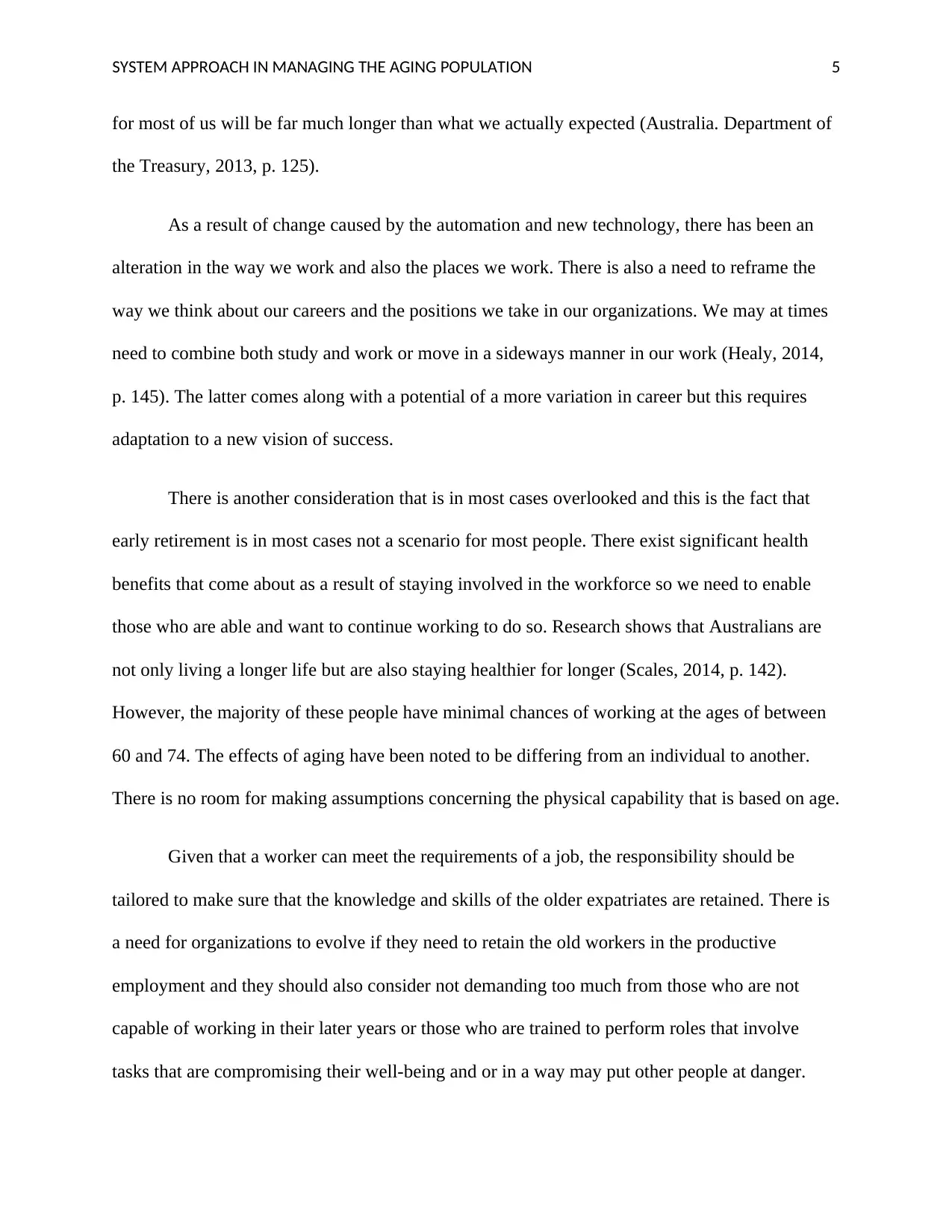
SYSTEM APPROACH IN MANAGING THE AGING POPULATION 5
for most of us will be far much longer than what we actually expected (Australia. Department of
the Treasury, 2013, p. 125).
As a result of change caused by the automation and new technology, there has been an
alteration in the way we work and also the places we work. There is also a need to reframe the
way we think about our careers and the positions we take in our organizations. We may at times
need to combine both study and work or move in a sideways manner in our work (Healy, 2014,
p. 145). The latter comes along with a potential of a more variation in career but this requires
adaptation to a new vision of success.
There is another consideration that is in most cases overlooked and this is the fact that
early retirement is in most cases not a scenario for most people. There exist significant health
benefits that come about as a result of staying involved in the workforce so we need to enable
those who are able and want to continue working to do so. Research shows that Australians are
not only living a longer life but are also staying healthier for longer (Scales, 2014, p. 142).
However, the majority of these people have minimal chances of working at the ages of between
60 and 74. The effects of aging have been noted to be differing from an individual to another.
There is no room for making assumptions concerning the physical capability that is based on age.
Given that a worker can meet the requirements of a job, the responsibility should be
tailored to make sure that the knowledge and skills of the older expatriates are retained. There is
a need for organizations to evolve if they need to retain the old workers in the productive
employment and they should also consider not demanding too much from those who are not
capable of working in their later years or those who are trained to perform roles that involve
tasks that are compromising their well-being and or in a way may put other people at danger.
for most of us will be far much longer than what we actually expected (Australia. Department of
the Treasury, 2013, p. 125).
As a result of change caused by the automation and new technology, there has been an
alteration in the way we work and also the places we work. There is also a need to reframe the
way we think about our careers and the positions we take in our organizations. We may at times
need to combine both study and work or move in a sideways manner in our work (Healy, 2014,
p. 145). The latter comes along with a potential of a more variation in career but this requires
adaptation to a new vision of success.
There is another consideration that is in most cases overlooked and this is the fact that
early retirement is in most cases not a scenario for most people. There exist significant health
benefits that come about as a result of staying involved in the workforce so we need to enable
those who are able and want to continue working to do so. Research shows that Australians are
not only living a longer life but are also staying healthier for longer (Scales, 2014, p. 142).
However, the majority of these people have minimal chances of working at the ages of between
60 and 74. The effects of aging have been noted to be differing from an individual to another.
There is no room for making assumptions concerning the physical capability that is based on age.
Given that a worker can meet the requirements of a job, the responsibility should be
tailored to make sure that the knowledge and skills of the older expatriates are retained. There is
a need for organizations to evolve if they need to retain the old workers in the productive
employment and they should also consider not demanding too much from those who are not
capable of working in their later years or those who are trained to perform roles that involve
tasks that are compromising their well-being and or in a way may put other people at danger.
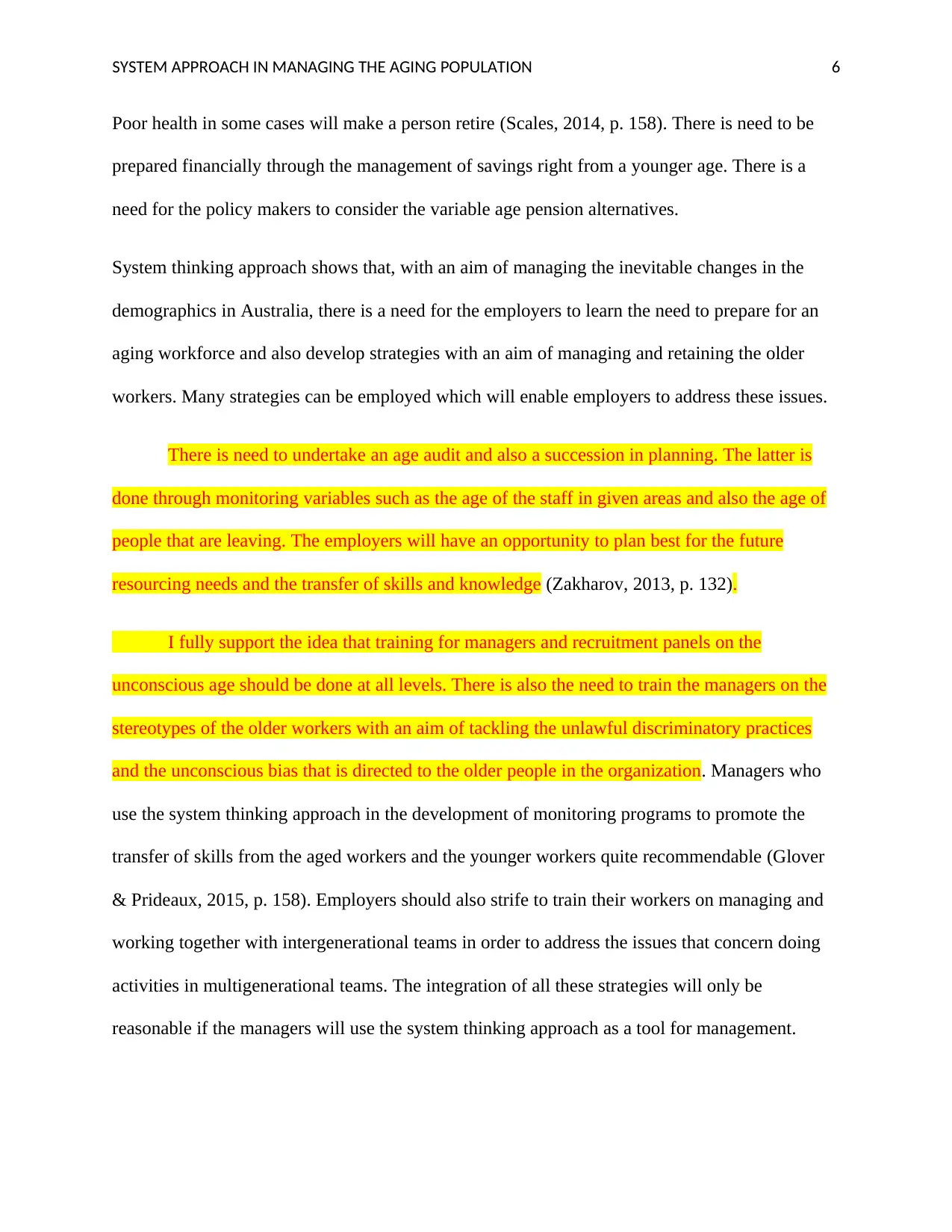
SYSTEM APPROACH IN MANAGING THE AGING POPULATION 6
Poor health in some cases will make a person retire (Scales, 2014, p. 158). There is need to be
prepared financially through the management of savings right from a younger age. There is a
need for the policy makers to consider the variable age pension alternatives.
System thinking approach shows that, with an aim of managing the inevitable changes in the
demographics in Australia, there is a need for the employers to learn the need to prepare for an
aging workforce and also develop strategies with an aim of managing and retaining the older
workers. Many strategies can be employed which will enable employers to address these issues.
There is need to undertake an age audit and also a succession in planning. The latter is
done through monitoring variables such as the age of the staff in given areas and also the age of
people that are leaving. The employers will have an opportunity to plan best for the future
resourcing needs and the transfer of skills and knowledge (Zakharov, 2013, p. 132).
I fully support the idea that training for managers and recruitment panels on the
unconscious age should be done at all levels. There is also the need to train the managers on the
stereotypes of the older workers with an aim of tackling the unlawful discriminatory practices
and the unconscious bias that is directed to the older people in the organization. Managers who
use the system thinking approach in the development of monitoring programs to promote the
transfer of skills from the aged workers and the younger workers quite recommendable (Glover
& Prideaux, 2015, p. 158). Employers should also strife to train their workers on managing and
working together with intergenerational teams in order to address the issues that concern doing
activities in multigenerational teams. The integration of all these strategies will only be
reasonable if the managers will use the system thinking approach as a tool for management.
Poor health in some cases will make a person retire (Scales, 2014, p. 158). There is need to be
prepared financially through the management of savings right from a younger age. There is a
need for the policy makers to consider the variable age pension alternatives.
System thinking approach shows that, with an aim of managing the inevitable changes in the
demographics in Australia, there is a need for the employers to learn the need to prepare for an
aging workforce and also develop strategies with an aim of managing and retaining the older
workers. Many strategies can be employed which will enable employers to address these issues.
There is need to undertake an age audit and also a succession in planning. The latter is
done through monitoring variables such as the age of the staff in given areas and also the age of
people that are leaving. The employers will have an opportunity to plan best for the future
resourcing needs and the transfer of skills and knowledge (Zakharov, 2013, p. 132).
I fully support the idea that training for managers and recruitment panels on the
unconscious age should be done at all levels. There is also the need to train the managers on the
stereotypes of the older workers with an aim of tackling the unlawful discriminatory practices
and the unconscious bias that is directed to the older people in the organization. Managers who
use the system thinking approach in the development of monitoring programs to promote the
transfer of skills from the aged workers and the younger workers quite recommendable (Glover
& Prideaux, 2015, p. 158). Employers should also strife to train their workers on managing and
working together with intergenerational teams in order to address the issues that concern doing
activities in multigenerational teams. The integration of all these strategies will only be
reasonable if the managers will use the system thinking approach as a tool for management.
⊘ This is a preview!⊘
Do you want full access?
Subscribe today to unlock all pages.

Trusted by 1+ million students worldwide
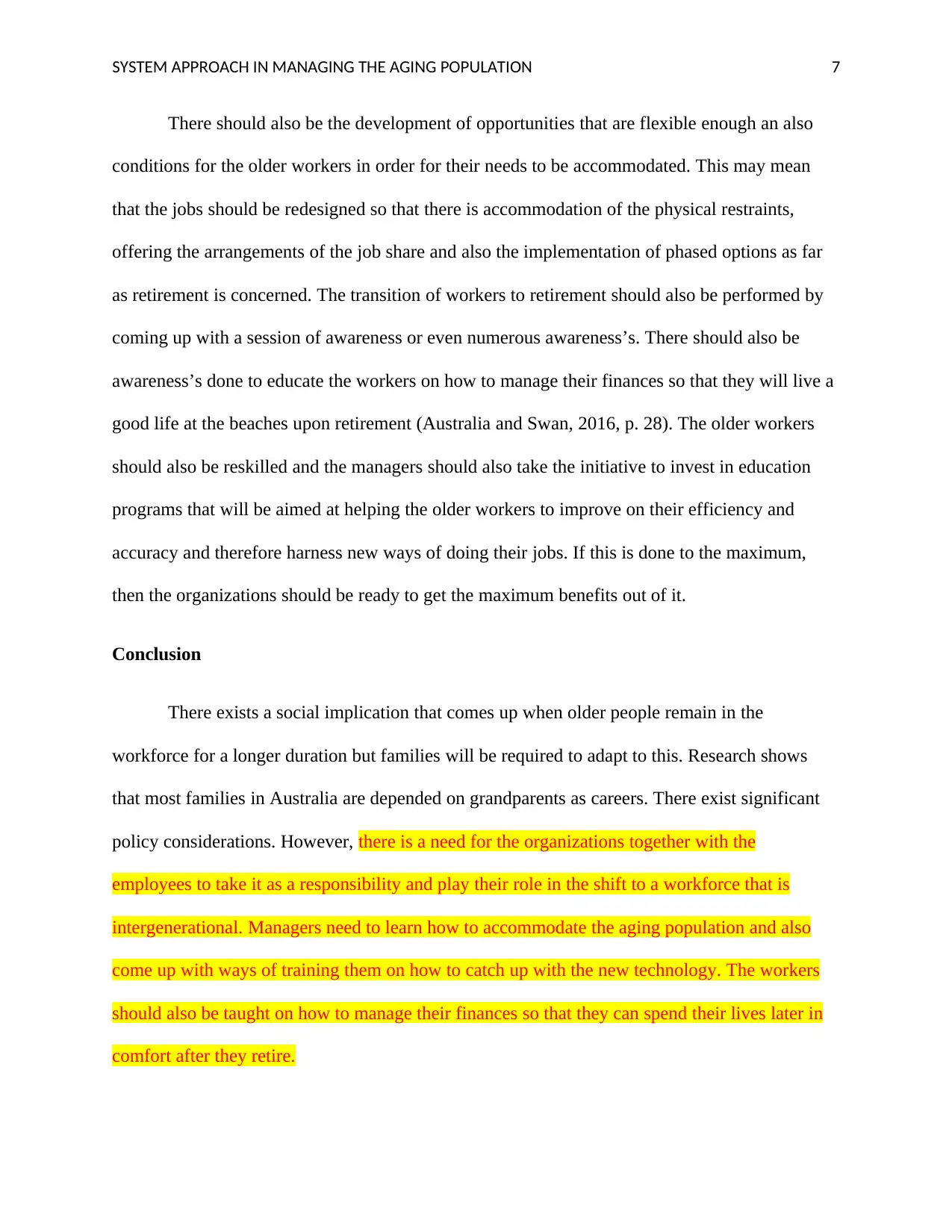
SYSTEM APPROACH IN MANAGING THE AGING POPULATION 7
There should also be the development of opportunities that are flexible enough an also
conditions for the older workers in order for their needs to be accommodated. This may mean
that the jobs should be redesigned so that there is accommodation of the physical restraints,
offering the arrangements of the job share and also the implementation of phased options as far
as retirement is concerned. The transition of workers to retirement should also be performed by
coming up with a session of awareness or even numerous awareness’s. There should also be
awareness’s done to educate the workers on how to manage their finances so that they will live a
good life at the beaches upon retirement (Australia and Swan, 2016, p. 28). The older workers
should also be reskilled and the managers should also take the initiative to invest in education
programs that will be aimed at helping the older workers to improve on their efficiency and
accuracy and therefore harness new ways of doing their jobs. If this is done to the maximum,
then the organizations should be ready to get the maximum benefits out of it.
Conclusion
There exists a social implication that comes up when older people remain in the
workforce for a longer duration but families will be required to adapt to this. Research shows
that most families in Australia are depended on grandparents as careers. There exist significant
policy considerations. However, there is a need for the organizations together with the
employees to take it as a responsibility and play their role in the shift to a workforce that is
intergenerational. Managers need to learn how to accommodate the aging population and also
come up with ways of training them on how to catch up with the new technology. The workers
should also be taught on how to manage their finances so that they can spend their lives later in
comfort after they retire.
There should also be the development of opportunities that are flexible enough an also
conditions for the older workers in order for their needs to be accommodated. This may mean
that the jobs should be redesigned so that there is accommodation of the physical restraints,
offering the arrangements of the job share and also the implementation of phased options as far
as retirement is concerned. The transition of workers to retirement should also be performed by
coming up with a session of awareness or even numerous awareness’s. There should also be
awareness’s done to educate the workers on how to manage their finances so that they will live a
good life at the beaches upon retirement (Australia and Swan, 2016, p. 28). The older workers
should also be reskilled and the managers should also take the initiative to invest in education
programs that will be aimed at helping the older workers to improve on their efficiency and
accuracy and therefore harness new ways of doing their jobs. If this is done to the maximum,
then the organizations should be ready to get the maximum benefits out of it.
Conclusion
There exists a social implication that comes up when older people remain in the
workforce for a longer duration but families will be required to adapt to this. Research shows
that most families in Australia are depended on grandparents as careers. There exist significant
policy considerations. However, there is a need for the organizations together with the
employees to take it as a responsibility and play their role in the shift to a workforce that is
intergenerational. Managers need to learn how to accommodate the aging population and also
come up with ways of training them on how to catch up with the new technology. The workers
should also be taught on how to manage their finances so that they can spend their lives later in
comfort after they retire.
Paraphrase This Document
Need a fresh take? Get an instant paraphrase of this document with our AI Paraphraser
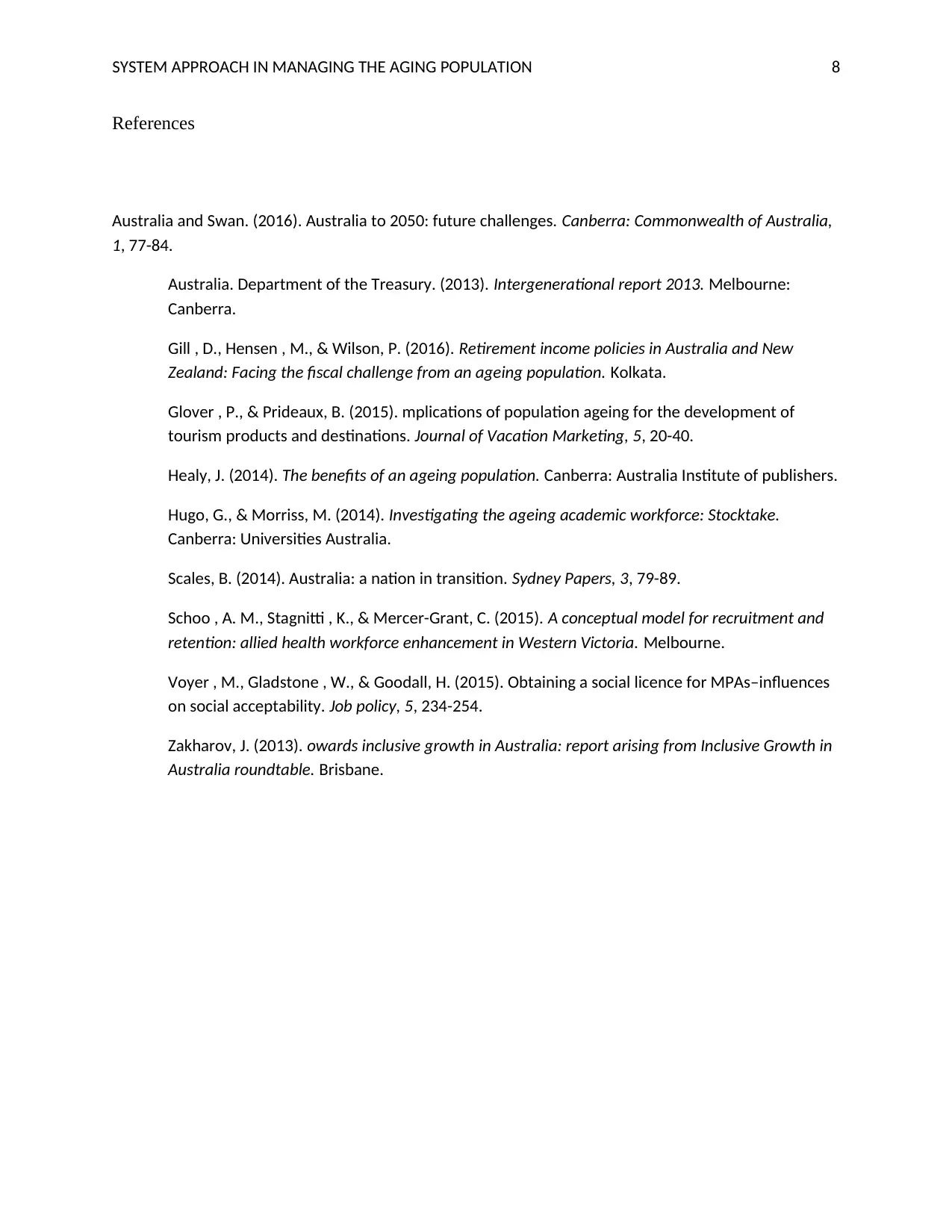
SYSTEM APPROACH IN MANAGING THE AGING POPULATION 8
References
Australia and Swan. (2016). Australia to 2050: future challenges. Canberra: Commonwealth of Australia,
1, 77-84.
Australia. Department of the Treasury. (2013). Intergenerational report 2013. Melbourne:
Canberra.
Gill , D., Hensen , M., & Wilson, P. (2016). Retirement income policies in Australia and New
Zealand: Facing the fiscal challenge from an ageing population. Kolkata.
Glover , P., & Prideaux, B. (2015). mplications of population ageing for the development of
tourism products and destinations. Journal of Vacation Marketing, 5, 20-40.
Healy, J. (2014). The benefits of an ageing population. Canberra: Australia Institute of publishers.
Hugo, G., & Morriss, M. (2014). Investigating the ageing academic workforce: Stocktake.
Canberra: Universities Australia.
Scales, B. (2014). Australia: a nation in transition. Sydney Papers, 3, 79-89.
Schoo , A. M., Stagnitti , K., & Mercer-Grant, C. (2015). A conceptual model for recruitment and
retention: allied health workforce enhancement in Western Victoria. Melbourne.
Voyer , M., Gladstone , W., & Goodall, H. (2015). Obtaining a social licence for MPAs–influences
on social acceptability. Job policy, 5, 234-254.
Zakharov, J. (2013). owards inclusive growth in Australia: report arising from Inclusive Growth in
Australia roundtable. Brisbane.
References
Australia and Swan. (2016). Australia to 2050: future challenges. Canberra: Commonwealth of Australia,
1, 77-84.
Australia. Department of the Treasury. (2013). Intergenerational report 2013. Melbourne:
Canberra.
Gill , D., Hensen , M., & Wilson, P. (2016). Retirement income policies in Australia and New
Zealand: Facing the fiscal challenge from an ageing population. Kolkata.
Glover , P., & Prideaux, B. (2015). mplications of population ageing for the development of
tourism products and destinations. Journal of Vacation Marketing, 5, 20-40.
Healy, J. (2014). The benefits of an ageing population. Canberra: Australia Institute of publishers.
Hugo, G., & Morriss, M. (2014). Investigating the ageing academic workforce: Stocktake.
Canberra: Universities Australia.
Scales, B. (2014). Australia: a nation in transition. Sydney Papers, 3, 79-89.
Schoo , A. M., Stagnitti , K., & Mercer-Grant, C. (2015). A conceptual model for recruitment and
retention: allied health workforce enhancement in Western Victoria. Melbourne.
Voyer , M., Gladstone , W., & Goodall, H. (2015). Obtaining a social licence for MPAs–influences
on social acceptability. Job policy, 5, 234-254.
Zakharov, J. (2013). owards inclusive growth in Australia: report arising from Inclusive Growth in
Australia roundtable. Brisbane.
1 out of 8
Related Documents
Your All-in-One AI-Powered Toolkit for Academic Success.
+13062052269
info@desklib.com
Available 24*7 on WhatsApp / Email
![[object Object]](/_next/static/media/star-bottom.7253800d.svg)
Unlock your academic potential
Copyright © 2020–2025 A2Z Services. All Rights Reserved. Developed and managed by ZUCOL.





